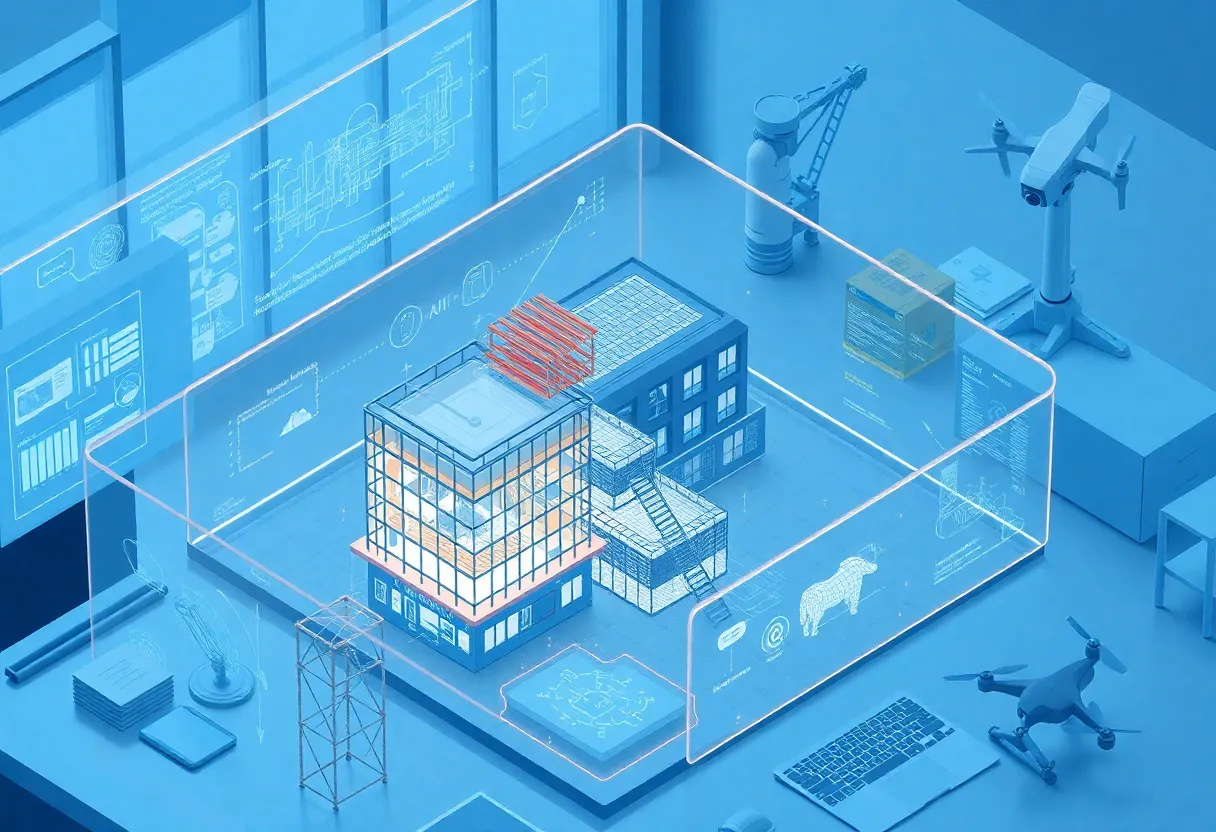Dublin, October 2, 2025
News Summary
A new strategic report finds the global construction design software market expanding from an estimated US$9.9 billion to US$15.4 billion, driven by a projected 7.7% CAGR. The study highlights core capabilities such as 2D drafting, 3D modeling, BIM, structural analysis and real-time collaboration. Adoption is accelerating due to BIM mandates, cloud platforms, AI-enabled generative design, digital twins, AR/VR and SaaS models that lower entry barriers. Demand rises across mature and emerging markets while modular construction, smart city projects and sustainability requirements further boost uptake among firms, education institutions and public infrastructure programs.
Construction design software market set to expand from US$9.9B in 2024 to US$15.4B by 2030
The global market for construction design tools is growing steadily as firms and governments push for digital planning and better project coordination. The global market for Construction Design Software was estimated at US$9.9 billion in 2024. The market is projected to reach US$15.4 billion by 2030. The compound annual growth rate (CAGR) projected from 2024 to 2030 is 7.7%. These figures come from a newly listed industry report added to an international market research service on October 02, 2025 at 04:36 ET with a Dublin location line and global distribution.
About the report and its scope
The report titled Construction Design Software – Global Strategic Business Report has been added to ResearchAndMarkets.com’s offering. The release states the report is comprehensive and provides an in-depth analysis of market trends, drivers, and forecasts to help make informed business decisions. Report features listed include: Key Insights; Scope of Study; Key Attributes. Key Attributes / sections named include MARKET OVERVIEW; MARKET TRENDS & DRIVERS; and FOCUS ON SELECT PLAYERS. The report features some of 34 companies.
What the software does
Construction design software is serving as a central tool for design and planning. Key capabilities called out in the report include:
- Construction design software enables 2D drafting.
- It enables 3D modeling.
- It enables Building Information Modeling (BIM).
- It enables structural analysis.
- It enables real-time collaboration among stakeholders.
How it changes AEC workflows
The report describes the role and benefits in everyday project workflows. Construction design software has become a cornerstone of modern architecture, engineering, and construction (AEC) workflows. These solutions transform how infrastructure and building projects are visualized, planned and executed. The tools streamline processes, enhance project accuracy, and reduce costs and time tied to manual revisions and on-site changes. Software is used to simulate construction sequencing; software is used to simulate energy performance; software is used for clash detection. Simulation and detection capabilities help mitigate risks before physical work begins. Such capabilities are critical in an industry where errors and inefficiencies can significantly impact budgets and timelines.
Market and regulatory drivers
Several forces are driving adoption. There is a shift from conventional CAD to advanced BIM systems, redefining design approaches in large-scale residential, commercial and infrastructure projects. Governments in regions such as North America, Europe and Asia‑Pacific are mandating BIM usage for public infrastructure planning. BIM mandates reinforce the software’s role in achieving sustainability, cost transparency and lifecycle asset management. The report also notes that regulatory mandates for digital documentation and compliance reporting reinforce software use across public and private projects. Smart city initiatives, sustainable construction mandates and green building certifications are pushing adoption of design tools for energy modeling, materials analysis and lifecycle forecasting. The expansion of modular and prefabricated construction drives demand for precision design software that supports off-site planning and factory-based component fabrication.
Technological trends
Innovation is reshaping tools and workflows. Innovations reshaping the landscape include cloud computing, artificial intelligence (AI), and digital twin technologies. Cloud-based platforms allow for real-time data sharing and team collaboration and enable multiple stakeholders to work on a single project model irrespective of location. AI integration supports generative design, improving creativity and design efficiency. Digital twin technology creates a real‑time digital representation of a physical building or infrastructure asset and is being incorporated into BIM platforms for lifecycle management. Augmented reality (AR) and virtual reality (VR) tools add immersive review options. Vendors are focusing on user experience and automation, while strategic partnerships with hardware providers and a shift to Software-as-a-Service (SaaS) and modular licensing lower entry barriers for small and mid-sized firms.
Where demand is growing
The report lists demand across both mature and emerging markets. Demand is growing in mature markets: United States, United Kingdom, Germany, Japan and Australia. It also notes rising demand in emerging markets: India, Indonesia, Vietnam and several African nations. Education institutions and technical training centers are adopting the tools to train new professionals, expanding the user base.
Business models and integrations
The report highlights that SaaS and modular licensing lower entry barriers for small and mid-sized firms. It also points out that design tools integrated with construction management software, ERP systems and procurement platforms are becoming valuable for end-to-end project planning.
Related reports and attachments
The release notes additional reports were added on the same date, including an offsite construction report and a hydropower plant construction report.
Local project examples and industry context
The release excerpt includes several project profiles that show design software in use. One commercial redevelopment project in downtown Dublin, California shows a developer receiving final approvals to demolish two vacant buildings and build a 33,125-square-foot multi-tenant building as relocation space for current tenants. On Aug. 20 the City Council approved a site development review permit allowing Hines to demolish two vacant commercial buildings on the site, construct a multi-tenant commercial building and reconfigure the site’s parking lot and access drives. The developer revised designs to add landscaping, reduce parking, shift the building nine feet north, enhance walkways with decorative concrete, and eliminate a one-way drive from Amador Valley Boulevard. The City Council voted 4–1 to approve the permit.
Other project excerpts show advanced digital design use: a signature pedestrian bridge in Dublin, Ohio used parametric and proprietary modeling tools to create its unique S‑curve geometry, and a new children’s hospital in Dublin, Ireland relied on thermal modelling, digital architecture and energy-efficient design to meet ambitious sustainability targets and BREEAM certification goals.
Why this matters for contractors and designers
Firms that adopt these tools can improve coordination, reduce rework, and better meet regulatory and sustainability requirements. The growing market and technology shifts make access to advanced features — cloud collaboration, AI, digital twins and modular license models — increasingly important for projects of all sizes.
FAQ
What was the market size in 2024?
The global market for Construction Design Software was estimated at US$9.9 billion in 2024.
What is the market projection for 2030?
The market is projected to reach US$15.4 billion by 2030.
What is the expected growth rate?
The compound annual growth rate (CAGR) projected from 2024 to 2030 is 7.7%.
What is the report title that was added?
The report titled Construction Design Software – Global Strategic Business Report has been added to ResearchAndMarkets.com’s offering.
What core functions does the software enable?
Construction design software enables 2D drafting. It enables 3D modeling. It enables Building Information Modeling (BIM). It enables structural analysis. It enables real-time collaboration among stakeholders.
How does the software affect AEC workflows?
Construction design software has become a cornerstone of modern architecture, engineering, and construction (AEC) workflows. These solutions transform how infrastructure and building projects are visualized, planned and executed.
What technological innovations are reshaping the landscape?
Innovations reshaping the landscape include cloud computing, artificial intelligence (AI), and digital twin technologies.
{
“@context”: “https://schema.org”,
“@type”: “FAQPage”,
“mainEntity”: [
{
“@type”: “Question”,
“name”: “What was the market size in 2024?”,
“acceptedAnswer”: {
“@type”: “Answer”,
“text”: “The global market for Construction Design Software was estimated at US$9.9 billion in 2024.”
}
},
{
“@type”: “Question”,
“name”: “What is the market projection for 2030?”,
“acceptedAnswer”: {
“@type”: “Answer”,
“text”: “The market is projected to reach US$15.4 billion by 2030.”
}
},
{
“@type”: “Question”,
“name”: “What is the expected growth rate?”,
“acceptedAnswer”: {
“@type”: “Answer”,
“text”: “The compound annual growth rate (CAGR) projected from 2024 to 2030 is 7.7%.”
}
},
{
“@type”: “Question”,
“name”: “What is the report title that was added?”,
“acceptedAnswer”: {
“@type”: “Answer”,
“text”: “The report titled Construction Design Software – Global Strategic Business Report has been added to ResearchAndMarkets.com’s offering.”
}
},
{
“@type”: “Question”,
“name”: “What core functions does the software enable?”,
“acceptedAnswer”: {
“@type”: “Answer”,
“text”: “Construction design software enables 2D drafting. It enables 3D modeling. It enables Building Information Modeling (BIM). It enables structural analysis. It enables real-time collaboration among stakeholders.”
}
},
{
“@type”: “Question”,
“name”: “How does the software affect AEC workflows?”,
“acceptedAnswer”: {
“@type”: “Answer”,
“text”: “Construction design software has become a cornerstone of modern architecture, engineering, and construction (AEC) workflows. These solutions transform how infrastructure and building projects are visualized, planned and executed.”
}
},
{
“@type”: “Question”,
“name”: “What technological innovations are reshaping the landscape?”,
“acceptedAnswer”: {
“@type”: “Answer”,
“text”: “Innovations reshaping the landscape include cloud computing, artificial intelligence (AI), and digital twin technologies.”
}
}
]
}
Key features at a glance
| Feature | What it does |
|---|---|
| 2D drafting | Core drawing and documentation capability used for plans and details. |
| 3D modeling | Creates three-dimensional representations for coordination and visualization. |
| BIM | Supports data-rich models for lifecycle asset management and compliance. |
| Structural analysis | Analyzes loads and behavior to inform engineering decisions. |
| Real-time collaboration | Allows multiple stakeholders to work on a single model across locations. |
| Cloud, AI, digital twins | Modern technologies that enable generative design, live monitoring and lifecycle simulation. |
| SaaS and modular licensing | Business models that lower entry barriers for small and mid-sized firms. |
Deeper Dive: News & Info About This Topic
Additional Resources
- GlobeNewswire: Construction Design Software – Global Strategic Business Report
- Wikipedia: Building information modeling
- ENR: The Dublin Link (Best Project — highway/bridge)
- Google Search: The Dublin Link bridge
- SFYIMBY: Construction soon for 6700 Golden Gate Drive West Dublin
- Google Scholar: 6700 Golden Gate Drive Dublin
- Pleasanton Weekly: Dublin council clears commercial building
- Encyclopedia Britannica: Dublin California downtown development
- Arup: New Children’s Hospital project
- Google News: construction design software digital twins BIM
Author: Construction CA News
The CALIFORNIA STAFF WRITER represents the experienced team at constructioncanews.com, your go-to source for actionable local news and information in California and beyond. Specializing in "news you can use," we cover essential topics like product reviews for personal and business needs, local business directories, politics, real estate trends, neighborhood insights, and state news affecting the area—with deep expertise drawn from years of dedicated reporting and strong community input, including local press releases and business updates. We deliver top reporting on high-value events such as the Rose Parade, Coachella, Comic-Con, and the California State Fair. Our coverage extends to key organizations like the California Building Industry Association and Associated General Contractors of California, plus leading businesses in technology and entertainment that power the local economy such as Apple and Alphabet. As part of the broader network, including constructionnynews.com, constructiontxnews.com, and constructionflnews.com, we provide comprehensive, credible insights into the dynamic landscape across multiple states.




